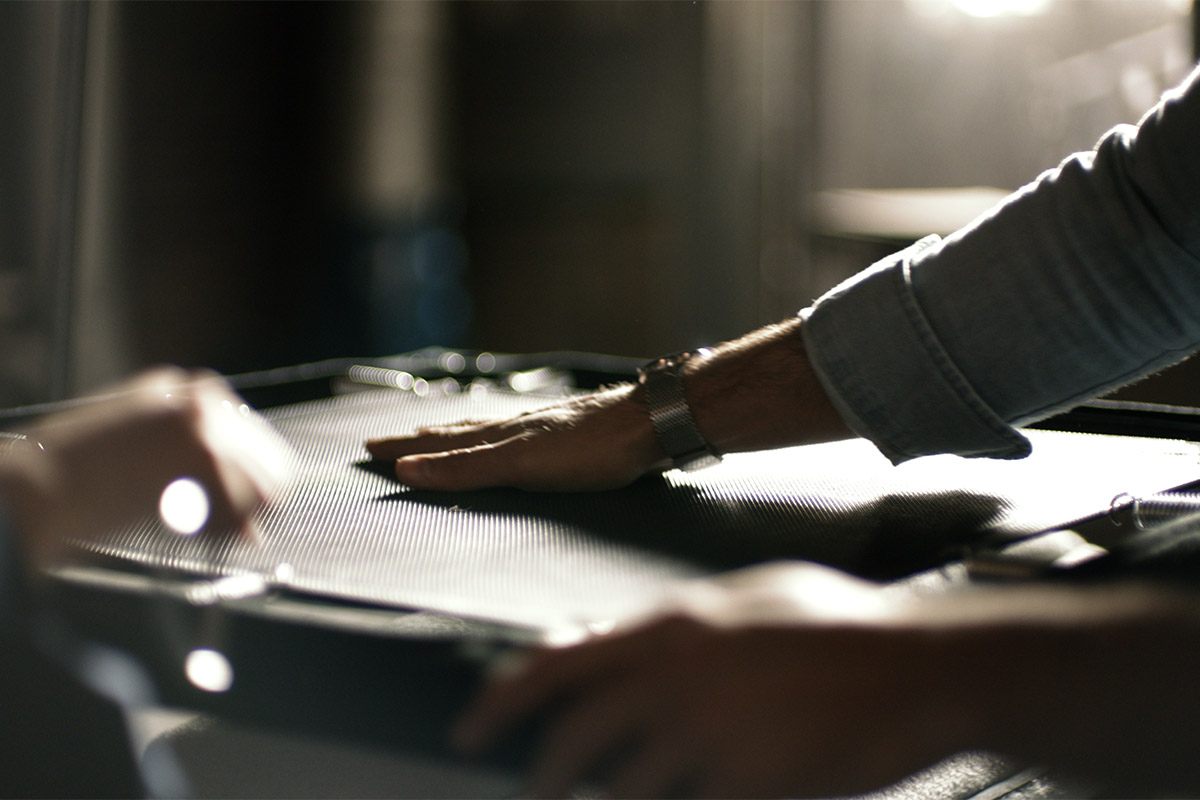Metal vs wood sofa frame: What is the difference?

Sofas come in a variety of styles, colours, textures, and sizes.
If you are looking at buying a new sofa, you may have already thought about all these things, but have you considered what is on the inside?
The quality of the internal frame and the materials used in construction are what separates a sofa that will last a lifetime from one that will end up on the curb after just a few years.
Typically, wood and metal are used for sofa frames, both of which are durable and provide years of comfortable seating.
The KING sofa frame is precision engineered from high-grade galvanised steel, however, there are also many respected furniture brands and designers who craft sofas with a wood fame. Here at KING, we think it’s important to give you an honest comparison of metal and wood sofa frames so you can make an informed decision.
In this article, we will look at how wood and metal sofa frames compare in the areas of sustainability, affordability and durability.
How do metal and wood sofa frames compare on sustainability

Metal
Many metals, including iron ore, are mined from the Earth's crust.
This makes metal a non-renewable resource and highly emission-intensive. This does not mean metal is entirely unsustainable. Metals are some of the most recyclable materials and can be repurposed for multiple uses.
Steel is made from iron ore and can be considered sustainable because it is entirely recyclable and can be reused infinite times.
Research by the Bureau of International Recycling found 630 million tonnes of steel scrap is recycled every year across the world, which saves around 950 million tonnes of CO2 emissions annually2.
On the other hand, mining raw materials is energy-intensive and releases greenhouse gases into the atmosphere. According to The Worldsteel Association, two billion tonnes of virgin steel is produced each year, generating around 8% of global CO2 emissions3. This makes the steel industry one of the largest producers of CO2 emissions.
The Worldsteel Association calculates for every tonne of scrap used in steel production avoids the emission of 1.5 tonnes of CO2—making scrap steel and metal recycling play a key role in reducing emissions and natural resource consumption4.
Like wood harvesting, there are sustainable mining practices, including scrap metal and advanced land rehabilitation techniques.
Unlike wood, metal is not susceptible to rot, termites, or mould. It also tends to be more durable and fire-resistant, unlike wood or plastic.

Wood
While wood is a renewable and recyclable natural resource, not all wood is equal, particularly when it comes to ethical standards and sustainability.
There is a vast difference between sustainably sourced wood and wood from unsustainable sources.
Certified sustainable wood is harvested from sustainably managed forests, which involves regeneration and efforts to prevent damage to ecosystems, wildlife, and wetlands. In some sustainable harvesting practices, up to ten trees are replanted for each tree cut down.
On the other hand, wood from unsustainable sources is logged without any regeneration or forest conservation efforts or considerations. The consequences of this can lead to wholesale destruction and devastation of natural habitats and indigenous communities.
According to Greenpeace, the most significant impacts of illegal logging include:
- Deforestation.
- Conflicts with indigenous and local populations.
- Human rights abuses.
- Loss of biodiversity and emission of greenhouse gases1.
Unfortunately, despite the best efforts of conservationists and governments, just 20 percent of the world's forest area is legally protected from destruction.
If you intend to buy wood furniture or wood products and want to ensure the wood is ethically and sustainably sourced, look for the Responsible Wood or Forest Stewardship Council (FSC) logos. Recognised under the Programme for the Endorsement of Forest Certification (PEFC), these leading bodies also regulate the use of illegal chemicals and conservation efforts.
How do metal and wood sofa frames compare on durability

Metal
The most significant advantage of using metals is strength and lifespan. Iron, aluminium, and stainless steel are the most common metals used in furniture design.
But, it’s important to note that not all metals are equal in quality or durability. Chemical compounds and how the metal was heat-treated or not treated impact the grade and longevity. For example, iron furniture is more prone to corrosion from exposure to moisture and air. This is different to galvanised steel furniture that has been adequately sealed and treated, which is typically resistant to humidity and erosion.
Precision engineered from high grade galvanised steel, the is built to last and comes with a 25-year warranty. For additional strength, the KING steel frame is precision spot welded at key stress and weight-bearing areas.
Wood
While wood is a naturally durable material, a wooden sofa frame is not exempt from warping, breaking, or flaws.
Cheaper and softer woods are typically more susceptible to warping and splintering making them less durable than a metal sofa frame.
On the other hand, wood frames constructed using mortise-and-tenon joinery and traditional carpentry tend to be stronger and more durable than those that are held together with glue and nails.
The level of durability will depend on the wood used and construction methods. Unsturdy joints are what can lead to your sofa getting wobbly and breaking.
In terms of strength and robustness, composite wood like MDF (medium-density fibreboard), plywood and particleboard frames are inferior to hardwoods.
Some of the most common hardwoods in furniture construction include walnut, maple, birch, oak, and bamboo. Of the hardwoods, kiln-dried hardwood is typically considered the most durable and suitable for furniture. Typically, kiln-drying removes 70-80% of the wood's moisture, which helps prevent warping and bowing5.
How do metal and wood sofa frames compare on affordability
The price of a wood frame sofa or a metal frame sofa will depend on the quality of the materials, as well as the methods used in construction.
Typically the price should reflect the quality of the sofa, the materials used and its expected longevity.
Metal
Yes, sofas engineered with a metal frame are typically more expensive.
While you might pay more for a metal frame sofa up-front, you will make up for the cost in its long lifespan. Metal frame sofas are built to last a lifetime, KING sofas come with a 25-year frame warranty.
Factors that influence the price of a metal frame sofa include the quality of the metal, the percentage of scrap metal used, the origin of the raw materials, the powder coating and construction methods.
You can expect to pay thousands for a quality metal frame sofa.
Wood
When it comes to a wooden sofa frame there are several factors that influence the price including the raw materials and whether traditional joinery methods were used.
Low-to-mid priced sofas often use glue, staples, and nails more than traditional labour-intensive techniques. While this can help reduce costs, it can also impact the quality and durability of the sofa. A sofa made with less durable and low-quality wood can cost as low as $500.
A more expensive and higher-quality sofa will typically rely less on the nails and staples and more on traditional carpentry such as mortise-and-tenon joinery.
Mortise-and-tenon joinery connects two pieces of wood at a 90-degree angle. One piece of wood has routed tabs (tenons) that fit perfectly into the carved holes (mortises) on the other piece of wood.
Certain types of wood are also more expensive, such as mahogany, teak, or oak. Sofas engineered with high quality and durable wood can also set consumers back thousands of dollars.
Metal vs wood sofa frame: which is right for you?
While exterior aesthetics visually separate one sofa from another, the craftsmanship and engineering will lead to the most significant divide in quality, longevity, and comfort.
When looking at the internal structure of a sofa, consider:
- The origins of the materials
- Harvesting or mining practices
- If the materials are recyclable or sustainable
- The expected longevity of the sofa
- Construction methods and finishes
Another thing to consider is your lifestyle and what you require from your sofa. If you have kids or host guests regularly, a modular sofa that can easily convert into a bed would be more suitable.
If this is the case, you will need a metal frame sofa. High grade galvanised steel gives KING sofas the strength required for modularity.
If you are concerned about the wood harvesting methods, you should research sustainable wood furniture or choose a sofa with a metal frame.
But, what makes a piece of furniture sustainable, and how can you ensure the furniture you are buying isn't destined for the curbs or landfills?
Discover the top considerations for buying sustainable furniture.














